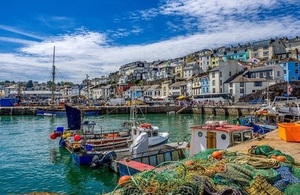Fishing industry in 2016 statistics published
The Marine Management Organisation (MMO) has published its annual UK sea fisheries annual statistics report 2016.

It includes details on the UK fleet, the number of fishermen, the quantity and value of UK landings, international trade, worldwide fishing and the state of key stocks.
The report highlights that in 2016:
- the quantity and value of sea fish (which include shellfish) landed by UK vessels has decreased by 1 per cent and increased by 21 per cent respectively on 2015
- UK vessels landed 701 thousand tonnes of sea fish into the UK and abroad with a value of £936 million
- the increase in value was primarily driven by large increases in market prices, in particular, for key pelagic and shellfish species. Pelagic landings are still far higher than they were a few years ago. Mackerel and herring accounted for 44 per cent of UK fleet landings but a lower share in value (26 per cent)
- the Scottish fleet caught mainly pelagic fish. Demersal fish account for the highest share of the English fleet’s catch and shellfish are predominately caught by the Welsh and Northern Irish fleets in 2016
- the UK fishing fleet remained seventh largest in the EU in terms of vessel numbers, with the second largest capacity and fourth largest engine power
- seventy two per cent of the quantity landed by the UK fleet was caught by vessels over 24 metres in length which accounted for 4 per cent of the total number of UK vessels. These vessels tend to catch lower value pelagic fish
- around 11,800 fishermen were active in the UK. Approximately 2,300 were part-time
- Scottish vessels accounted for 65 per cent of the quantity of landings by the UK fleet while English vessels accounted for 29 per cent.
- Peterhead remained the port with the highest landings – 145 thousand tonnes with a value of £158 million
- Newlyn had the highest quantity of landings in England – 14,100 tonnes with a value of £28 million, closely followed by Brixham with 13,300 tonnes but with the higher value of £31 million
- exports of fish were little changed at 441 thousand tonnes. Imports rose by 7 per cent to 730 thousand tonnes
- world figures for 2015 showed that China caught the largest amount of fish, 15.5 million tonnes. Indonesia had the second largest catch at 6.0 million tonnes
Economic Exclusive Zone (EEZ)
In addition to the annual report there will be a further breakdown of landings by Economic Exclusive Zone (EEZ).
The report highlights that in 2016, the:
- UK caught the majority of its fish, 81% by quantity, in its own EEZ. With other EU member states’ EEZs being the next most important zone of capture, at 11% by quantity
- UK fleet landed 571,000 tonnes of fish worth £774 million from the UK EEZ with Mackerel, Nephrops and King Scallop landings accounting for 43% of this total value
- Northern North Sea (ICES Area Iva), worth £308 million, was the most valuable fishing area for UK vessels in the UK EEZ
We are continually working with the fishing industry to improve day-to-day management with accurate catch limits and forecasts that secure longer fisheries, while safeguarding the welfare of fish stocks.
Further information
Telephone: 0300 123 1032
Email: media@marinemanagement.org.uk